Abstract
1. The aim of the present studies was to examine the effects of nitric oxide donors on arrhythmias induced by coronary artery occlusion and reperfusion, and on cardiac cyclic nucleotides. Experiments were performed in pentobarbitone-anaesthetized rats prepared for occlusion of the left coronary artery. 2. Sodium nitroprusside (0.1, 0.3 and 1 microgram kg-1 min-1) had no significant effects on the incidence of ventricular tachycardia, total ventricular fibrillation or the mortality resulting from 25 min of acute myocardial ischaemia when compared with values in controls. In addition, there was no alteration in the number of ventricular premature beats that occurred in survivors. 3. 3-Morpholinosydnonimine-N-ethylcarbamide (SIN-1, 10, 20 and 40 micrograms kg-1 min-1) caused marked hypotension but did not alter the incidence or severity of ischaemia-induced arrhythmias. In rats subject to abrupt reperfusion after 5 min of myocardial ischaemia, lower doses of SIN-1 (1, 3 and 10 micrograms kg-1 min-1) still caused significant reductions in systolic and diastolic blood pressure but were devoid of antiarrhythmic activity. 4. In separate experiments in sham-operated rats, sodium nitroprusside (1 microgram kg-1 min-1), isosorbide dinitrate (30 and 60 micrograms kg-1 min-1) and SIN-1 (20 and 40 micrograms kg-1 min-1) had no significant effects on cardiac cyclic GMP content. 5. These results indicate that nitric oxide donors do not alter arrhythmias induced by acute coronary artery occlusion or reperfusion in anaesthetized rats.(ABSTRACT TRUNCATED AT 250 WORDS)
Full text
PDF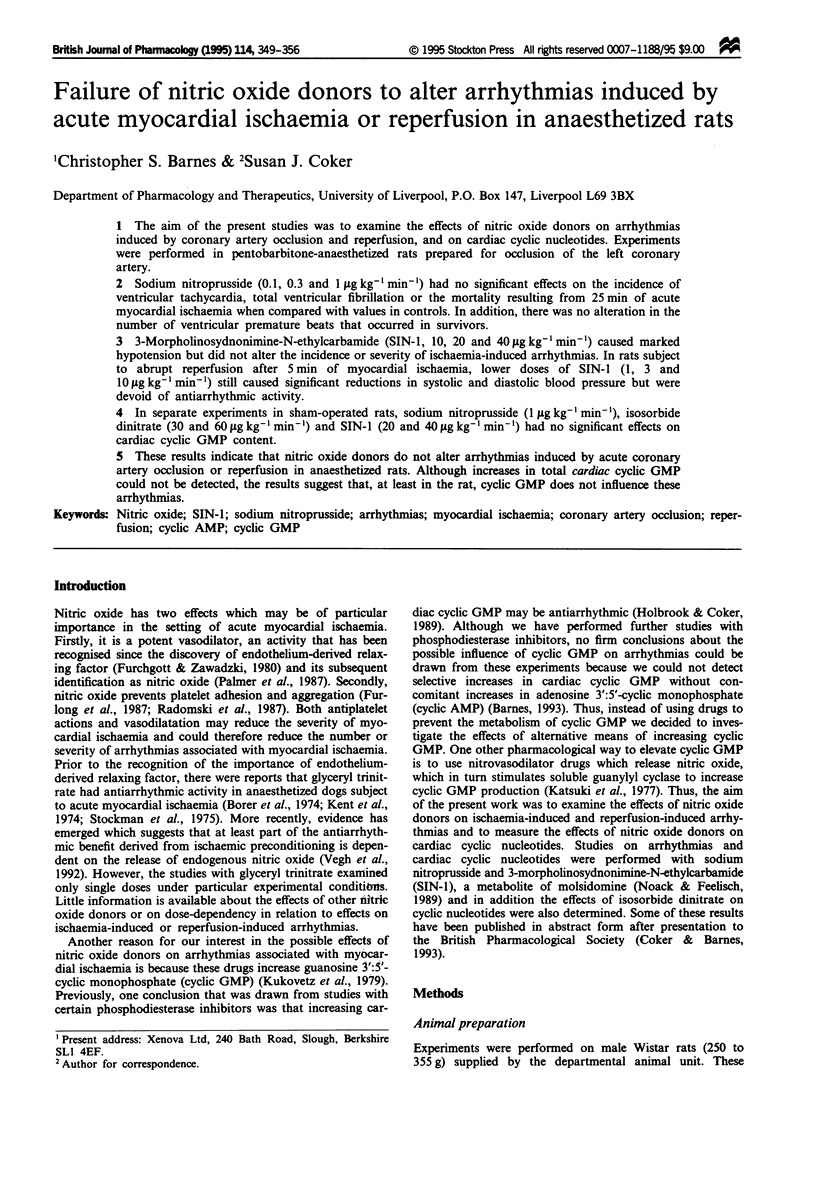



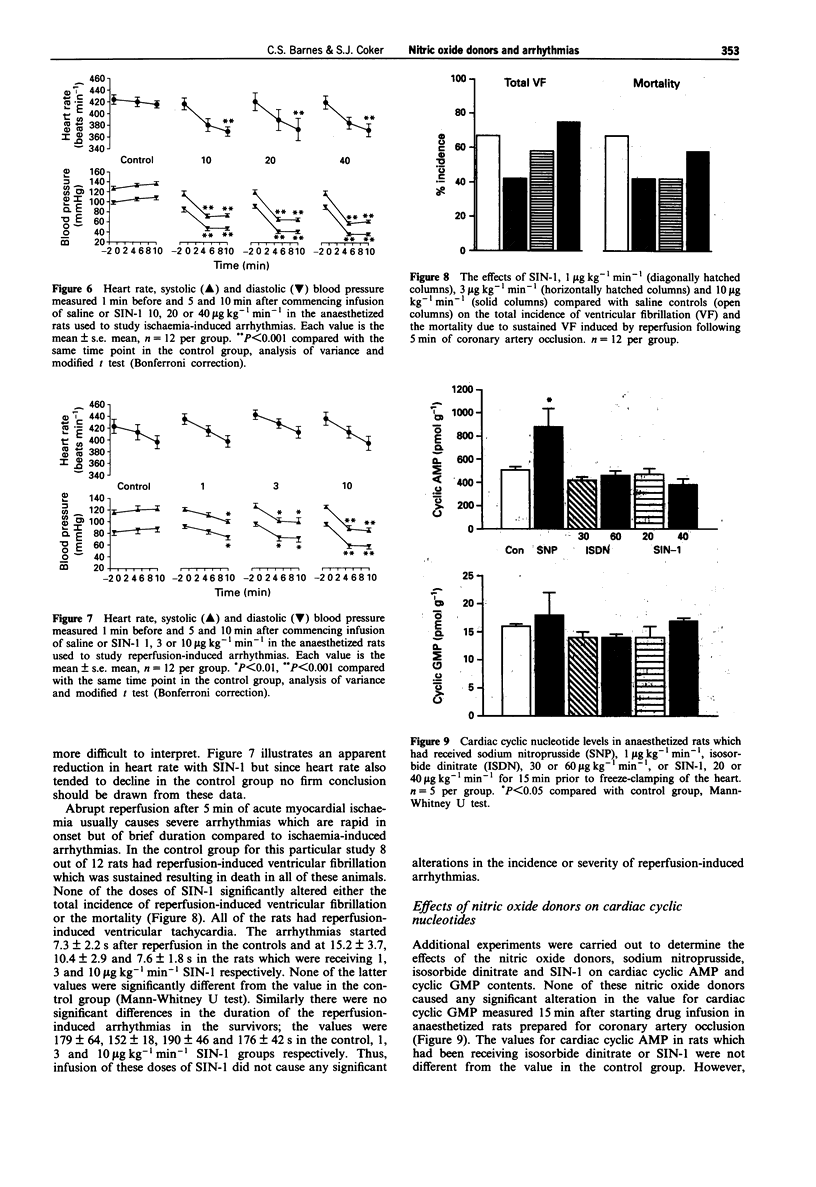
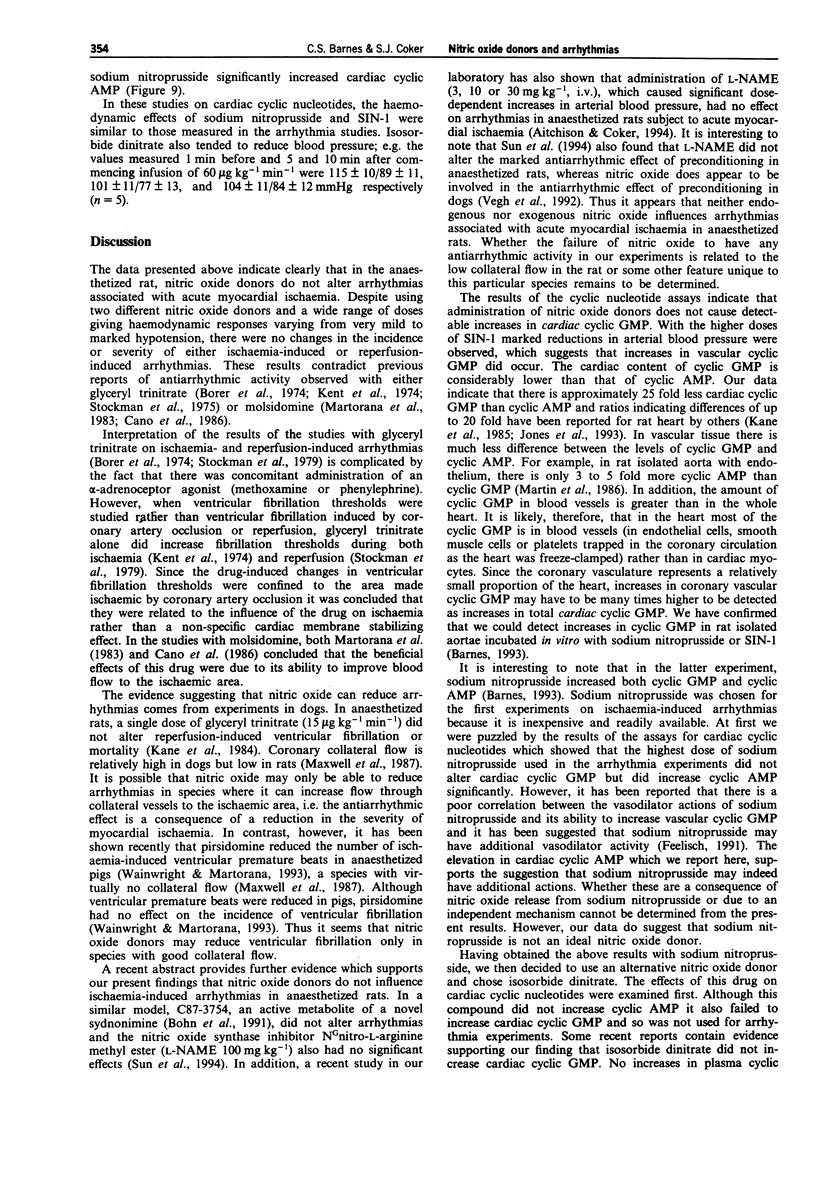
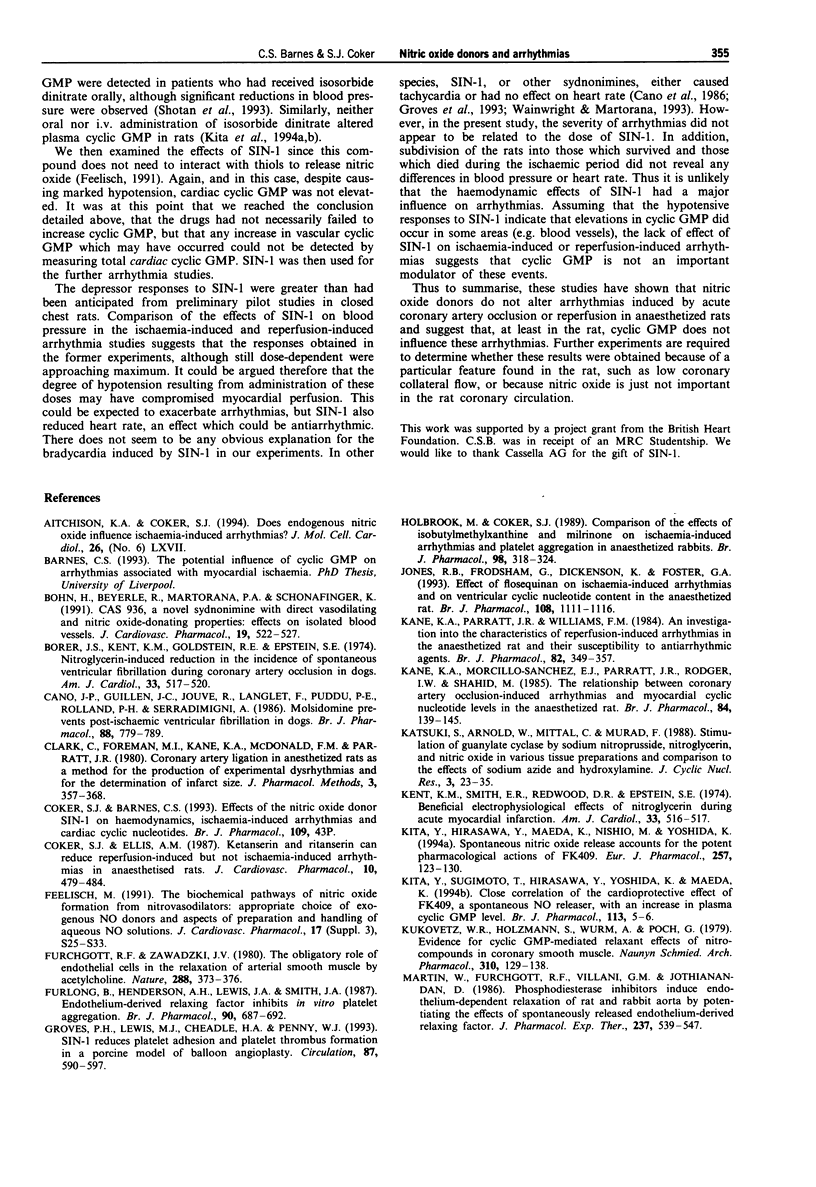
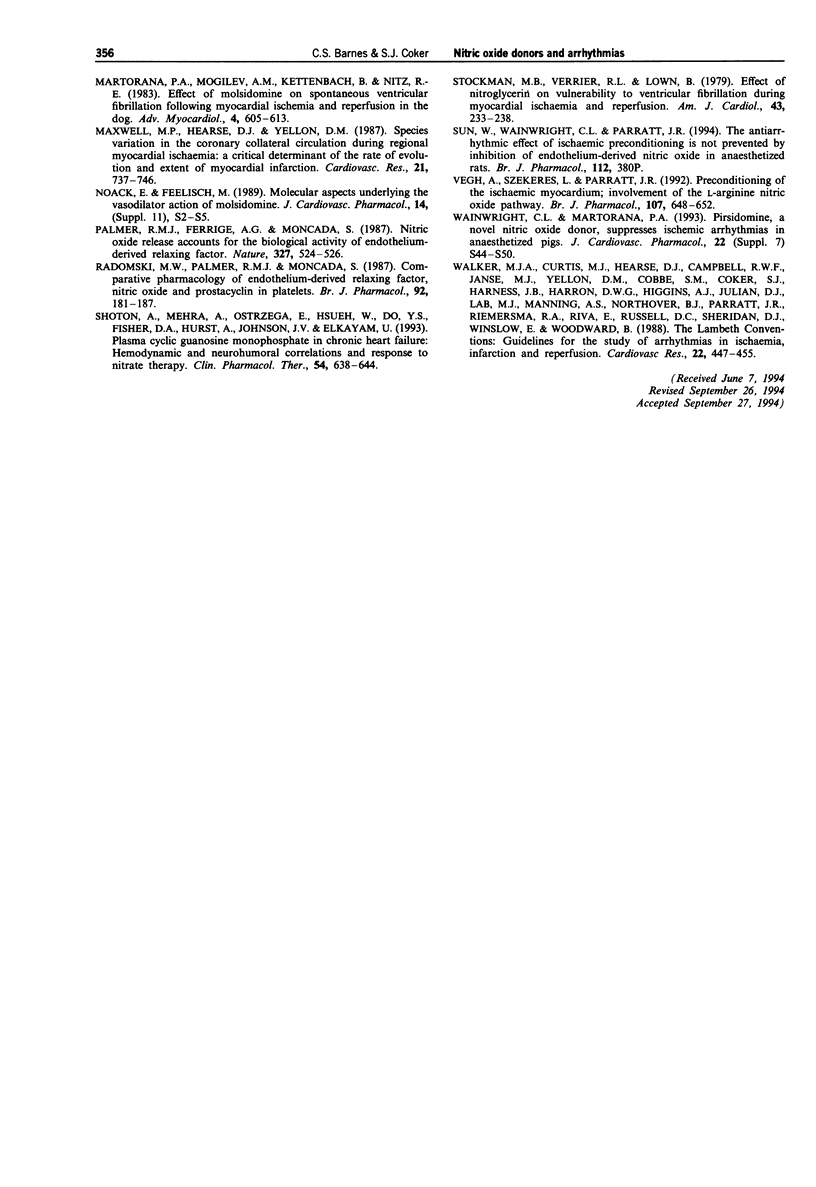
Selected References
These references are in PubMed. This may not be the complete list of references from this article.
- Bohn H., Beyerle R., Martorana P. A., Schönafinger K. CAS 936, a novel syndnonimine with direct vasodilating and nitric oxide-donating properties: effects on isolated blood vessels. J Cardiovasc Pharmacol. 1991 Oct;18(4):522–527. doi: 10.1097/00005344-199110000-00007. [DOI] [PubMed] [Google Scholar]
- Borer J. S., Kent K. M., Goldstein R. E., Epstein S. E. Nitroglycerin-induced reduction in the incidence of spontaneous ventricular fibrillation during coronary occlusion in dogs. Am J Cardiol. 1974 Apr;33(4):517–520. doi: 10.1016/0002-9149(74)90611-0. [DOI] [PubMed] [Google Scholar]
- Cano J. P., Guillen J. C., Jouve R., Langlet F., Puddu P. E., Rolland P. H., Serradimigni A. Molsidomine prevents post-ischaemic ventricular fibrillation in dogs. Br J Pharmacol. 1986 Aug;88(4):779–789. doi: 10.1111/j.1476-5381.1986.tb16250.x. [DOI] [PMC free article] [PubMed] [Google Scholar]
- Clark C., Foreman M. I., Kane K. A., McDonald F. M., Parratt J. R. Coronary artery ligation in anesthetized rats as a method for the production of experimental dysrhythmias and for the determination of infarct size. J Pharmacol Methods. 1980 Jun;3(4):357–368. doi: 10.1016/0160-5402(80)90077-7. [DOI] [PubMed] [Google Scholar]
- Coker S. J., Ellis A. M. Ketanserin and ritanserin can reduce reperfusion-induced but not ischaemia-induced arrhythmias in anaesthetised rats. J Cardiovasc Pharmacol. 1987 Oct;10(4):479–484. doi: 10.1097/00005344-198710000-00015. [DOI] [PubMed] [Google Scholar]
- Furchgott R. F., Zawadzki J. V. The obligatory role of endothelial cells in the relaxation of arterial smooth muscle by acetylcholine. Nature. 1980 Nov 27;288(5789):373–376. doi: 10.1038/288373a0. [DOI] [PubMed] [Google Scholar]
- Furlong B., Henderson A. H., Lewis M. J., Smith J. A. Endothelium-derived relaxing factor inhibits in vitro platelet aggregation. Br J Pharmacol. 1987 Apr;90(4):687–692. doi: 10.1111/j.1476-5381.1987.tb11221.x. [DOI] [PMC free article] [PubMed] [Google Scholar]
- Groves P. H., Lewis M. J., Cheadle H. A., Penny W. J. SIN-1 reduces platelet adhesion and platelet thrombus formation in a porcine model of balloon angioplasty. Circulation. 1993 Feb;87(2):590–597. doi: 10.1161/01.cir.87.2.590. [DOI] [PubMed] [Google Scholar]
- Holbrook M., Coker S. J. Comparison of the effects of isobutylmethylxanthine and milrinone on ischaemia-induced arrhythmias and platelet aggregation in anaesthetized rabbits. Br J Pharmacol. 1989 Sep;98(1):318–324. doi: 10.1111/j.1476-5381.1989.tb16897.x. [DOI] [PMC free article] [PubMed] [Google Scholar]
- Jones R. B., Frodsham G., Dickinson K., Foster G. A. Effect of flosequinan on ischaemia-induced arrhythmias and on ventricular cyclic nucleotide content in the anaesthetized rat. Br J Pharmacol. 1993 Apr;108(4):1111–1116. doi: 10.1111/j.1476-5381.1993.tb13513.x. [DOI] [PMC free article] [PubMed] [Google Scholar]
- Kane K. A., Morcillo-Sanchez E. J., Parratt J. R., Rodger I. W., Shahid M. The relationship between coronary artery occlusion-induced arrhythmias and myocardial cyclic nucleotide levels in the anaesthetized rat. Br J Pharmacol. 1985 Jan;84(1):139–145. [PMC free article] [PubMed] [Google Scholar]
- Kane K. A., Parratt J. R., Williams F. M. An investigation into the characteristics of reperfusion-induced arrhythmias in the anaesthetized rat and their susceptibility to antiarrhythmic agents. Br J Pharmacol. 1984 Jun;82(2):349–357. doi: 10.1111/j.1476-5381.1984.tb10769.x. [DOI] [PMC free article] [PubMed] [Google Scholar]
- Katsuki S., Arnold W., Mittal C., Murad F. Stimulation of guanylate cyclase by sodium nitroprusside, nitroglycerin and nitric oxide in various tissue preparations and comparison to the effects of sodium azide and hydroxylamine. J Cyclic Nucleotide Res. 1977 Feb;3(1):23–35. [PubMed] [Google Scholar]
- Kent K. M., Smith E. R., Redwood D. R., Epstein S. E. Beneficial electrophysiologic effects of nitroglycerin during acute myocardial infarction. Am J Cardiol. 1974 Apr;33(4):513–516. doi: 10.1016/0002-9149(74)90610-9. [DOI] [PubMed] [Google Scholar]
- Kita Y., Hirasawa Y., Maeda K., Nishio M., Yoshida K. Spontaneous nitric oxide release accounts for the potent pharmacological actions of FK409. Eur J Pharmacol. 1994 May 12;257(1-2):123–130. doi: 10.1016/0014-2999(94)90703-x. [DOI] [PubMed] [Google Scholar]
- Kita Y., Sugimoto T., Hirasawa Y., Yoshida K., Maeda K. Close correlation of the cardioprotective effect of FK409, a spontaneous NO releaser, with an increase in plasma cyclic GMP level. Br J Pharmacol. 1994 Sep;113(1):5–6. doi: 10.1111/j.1476-5381.1994.tb16165.x. [DOI] [PMC free article] [PubMed] [Google Scholar]
- Kukovetz W. R., Holzmann S., Wurm A., Pöch G. Evidence for cyclic GMP-mediated relaxant effects of nitro-compounds in coronary smooth muscle. Naunyn Schmiedebergs Arch Pharmacol. 1979 Dec;310(2):129–138. doi: 10.1007/BF00500277. [DOI] [PubMed] [Google Scholar]
- Martin W., Furchgott R. F., Villani G. M., Jothianandan D. Phosphodiesterase inhibitors induce endothelium-dependent relaxation of rat and rabbit aorta by potentiating the effects of spontaneously released endothelium-derived relaxing factor. J Pharmacol Exp Ther. 1986 May;237(2):539–547. [PubMed] [Google Scholar]
- Martorana P. A., Mogilev A. M., Kettenbach B., Nitz R. E. Effect of molsidomine on spontaneous ventricular fibrillation following myocardial ischemia and reperfusion in the dog. Adv Myocardiol. 1983;4:605–613. doi: 10.1007/978-1-4757-4441-5_59. [DOI] [PubMed] [Google Scholar]
- Maxwell M. P., Hearse D. J., Yellon D. M. Species variation in the coronary collateral circulation during regional myocardial ischaemia: a critical determinant of the rate of evolution and extent of myocardial infarction. Cardiovasc Res. 1987 Oct;21(10):737–746. doi: 10.1093/cvr/21.10.737. [DOI] [PubMed] [Google Scholar]
- Palmer R. M., Ferrige A. G., Moncada S. Nitric oxide release accounts for the biological activity of endothelium-derived relaxing factor. Nature. 1987 Jun 11;327(6122):524–526. doi: 10.1038/327524a0. [DOI] [PubMed] [Google Scholar]
- Radomski M. W., Palmer R. M., Moncada S. Comparative pharmacology of endothelium-derived relaxing factor, nitric oxide and prostacyclin in platelets. Br J Pharmacol. 1987 Sep;92(1):181–187. doi: 10.1111/j.1476-5381.1987.tb11310.x. [DOI] [PMC free article] [PubMed] [Google Scholar]
- Shotan A., Mehra A., Ostrzega E., Hsueh W., Do Y. S., Fisher D. A., Hurst A., Johnson J. V., Elkayam U. Plasma cyclic guanosine monophosphate in chronic heart failure: hemodynamic and neurohormonal correlations and response to nitrate therapy. Clin Pharmacol Ther. 1993 Dec;54(6):638–644. doi: 10.1038/clpt.1993.201. [DOI] [PubMed] [Google Scholar]
- Stockman M. B., Verrier R. L., Lown B. Effect of nitroglycerin on vulnerability to ventricular fibrillation during myocardial ischemia and reperfusion. Am J Cardiol. 1979 Feb;43(2):233–238. doi: 10.1016/s0002-9149(79)80009-0. [DOI] [PubMed] [Google Scholar]
- Vegh A., Szekeres L., Parratt J. Preconditioning of the ischaemic myocardium; involvement of the L-arginine nitric oxide pathway. Br J Pharmacol. 1992 Nov;107(3):648–652. doi: 10.1111/j.1476-5381.1992.tb14501.x. [DOI] [PMC free article] [PubMed] [Google Scholar]
- Wainwright C. L., Martorana P. A. Pirsidomine, a novel nitric oxide donor, suppresses ischemic arrhythmias in anesthetized pigs. J Cardiovasc Pharmacol. 1993;22 (Suppl 7):S44–S50. [PubMed] [Google Scholar]
- Walker M. J., Curtis M. J., Hearse D. J., Campbell R. W., Janse M. J., Yellon D. M., Cobbe S. M., Coker S. J., Harness J. B., Harron D. W. The Lambeth Conventions: guidelines for the study of arrhythmias in ischaemia infarction, and reperfusion. Cardiovasc Res. 1988 Jul;22(7):447–455. doi: 10.1093/cvr/22.7.447. [DOI] [PubMed] [Google Scholar]


